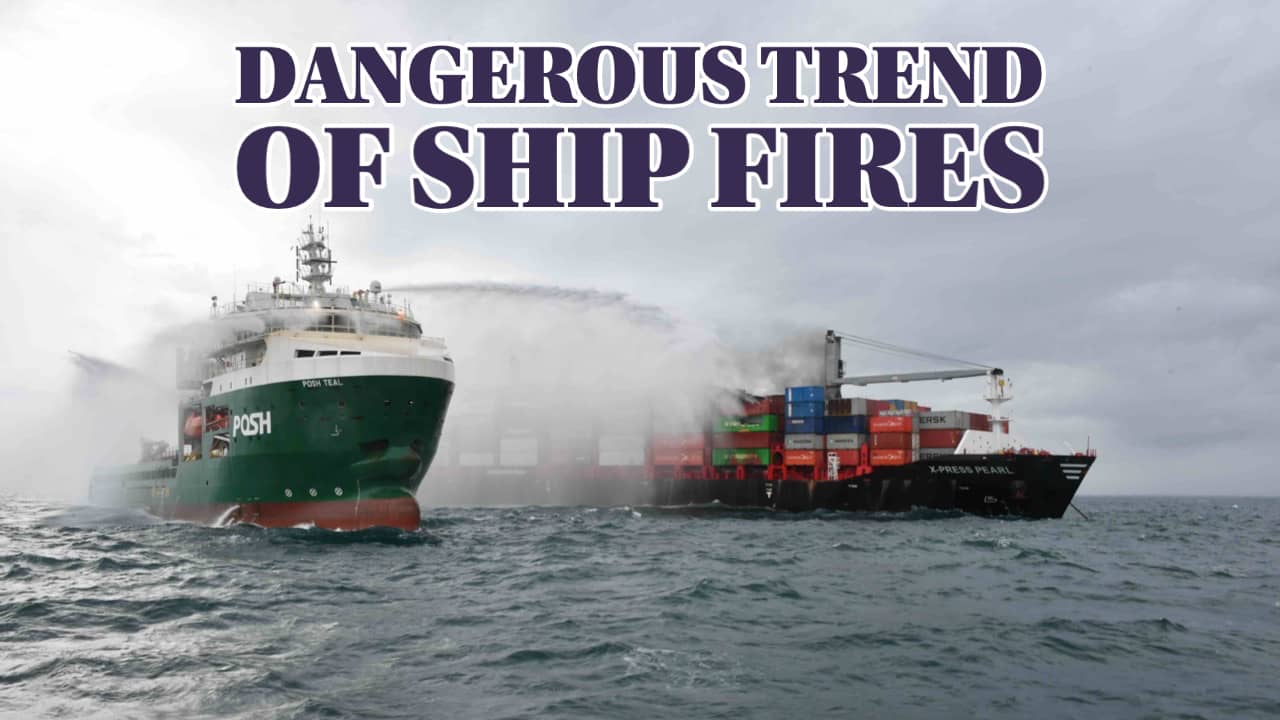
Have a Peace of Mind – Invest in Cargo Insurance
5-minute read
It takes something unusual for shipping to catch the attention of the mainstream public – such as the Ever Given blocking the Suez Canal – or the fire onboard the Felicity Ace and her subsequent sinking.
That interest wasn’t so much in the fact it was a ship fire – it was the fact that she was full of luxury cars. The thought of 4000 Volkswagen-Audi Group vehicles going to the bottom of the sea, with a value of something like NZ$550 million, became an international fascination.
However, it was another sad statistic for the shipping world, adding to the number of ship fires that have beset the industry.
Fortunately, there were no casualties on board the Felicity Ace, with her crew, evacuated off to other vessels that came to assist. That hasn’t always been the case with ship fires.
Five people died in 2018 when a fire broke out on the ultra-large container ship Maersk Honam after she caught fire in the Arabian Sea en route from Singapore to Suez.
Another instance of a fatal fire is the 6750-TEU vessel MSC Flaminia which caught fire in 2012, forcing the crew to abandon ship in the middle of the Atlantic Ocean. The fire led to an explosion and claimed three lives.
Amazingly, while the Felicity Ace grabbed the news headlines, another fatal Ro-Ro ship fire had occurred. At least eight people died on the Euroferry Olympia, which caught fire off Corfu.
At the time of writing, no official statement was released pinpointing the cause of the Euroferry Olympia fire, although owners Grimaldi suggested it began in a truck.
We’ll probably never know the cause of the Felicity Ace blaze, other than that flames were noticed emanating from her main deck. The ship lies at a depth of between 600 to 3000 metres, around 220 nautical miles off the Azores, which renders the chance of a meaningful accident investigation problematic.

That’s the case with another fatal fire on a Ro-Ro ship, the Grande America, which sank in the Bay of Biscay in 2019, for which the cause remains unknown.
Another recent ship fire took place late last year onboard the Zim Kingston en route to Vancouver, but we do seem to know the cause.
She was at an anchorage awaiting a berthing slot at the port of Vancouver when a storm caused a severe list, resulting in a container stack collapse.
This caused the loss of some 40 containers overboard, but more importantly, the damage was done to boxes containing dangerous goods, which ignited.
Stack collapses have been pointed to as a genuine cause for concern in ship safety, along with flawed cargo declarations whereby the carrier is unaware of the dangerous nature of some contents.
Despite the importance of dangerous goods compliance due to the immense danger to life and limb, as well as to cargo, ship and port infrastructure, there continue to be instances of misdeclaration, errors in manifests or failure to declare dangerous cargo.
US Coast Guard Sector Los Angeles-Long Beach received a report on 4 March this year of a shipping container on fire at the San Pedro Bay port complex at LA/Long Beach. The box was due to be loaded on a vessel sailing for China on March 10 and was waiting on the quay.
Forty firefighters extinguished the fire, though their efforts were impeded by the fact that the container was misdeclared, according to the Coast Guard.
The bill of lading for the container indicated that it carried “synthetic resins,” a non-hazardous material. But inside the container were used lithium-ion batteries, which are a hazardous material with a high risk of fire, reported Maritime News.
“Undeclared hazardous materials pose a severe risk to the safety of cargo vessels, the ports, and first responders,” said Captain Rebecca Ore, Captain of the Port and Commanding Officer of US Coast Guard Sector LA/Long Beach.
While stack collapses apply to container ships, pure car and truck carriers and deepsea Ro-Ro ships also can record instances of fires, along with the ones mentioned above.
An increasing trend is also for the carriage of electric vehicles fitted with banks of lithium batteries, which opens up a new potential area of risk.

There is precedent for vehicle batteries to cause a ship fire. An electrical fault from an improperly disconnected battery in a used vehicle led to the fire on board the Hoegh Xiamen in 2020. The vessel burnt out following an explosion on one of its car decks after just completing loading operations at Jacksonville.
It took over a week to extinguish that fire, which resulted in the vessel being declared a constructive total loss and a US$26 million payout on hull cover. The cargo of 2420 used vehicles was also declared a total loss valued at US$40 million, with the liability falling on the cargo insurers.
Operationally, the issue of dangerous goods carriage as a source of fire risk has become more problematic in the container supply chain because of the current worldwide problem of congestion.
Boxes can be on a ship sitting off a port for six or seven weeks. If they happen to be in a hot climate, will the stability of the dangerous goods be affected? Will chemicals, for example, remain inert when subject to a long period of heat?
Hapag-Lloyd senior director Ken Rohlmann recently raised this as a concern and said he had been unable to gain assurances from chemical manufacturers as to how their commodity might be affected by long-standing.
He said supply chain delays represent an unknown new kind of risk – “It is a question that has not been asked before because the problem did not exist.
“Now, with these interruptions to the supply chain, we see more and more stranded dangerous goods containers. You have a commodity where you don’t know how the delay may affect the chemical properties. We need to discuss and evaluate the risk.”
“Unless delays have been taken into account upfront, there is a risk that cargo protected by a chemical inhibitor or refrigeration might deteriorate to the extent that it becomes more hazardous,” commented Peregrine Storrs-Fox, the TT Club risk management director who is also concerned about the delays in shipping and their impact on safety.
There is also precedent for this to be a contributory factor in ship fires. The casualty report into the fire on board MSC Flaminia found that one of the contributory causes was the storage of a chemical compound for ten days in hot weather that hastened its deterioration.
With such a history of fires onboard vessels of all types, these latest cases will have repercussions in several ways.
For a start, huge insurance claims will be filed for destroyed, lost or damaged cargo. The value of the cargo of luxury cars onboard the Felicity Ace is a case in point. The legal repercussions could go on for years as courts try to determine why the accident happened and whose fault it was.
In container shipping, the size of vessels has increased markedly over the last decade, with the largest ships now well over 20,000 TEUs.
Logically, therefore, one has to expect that any incident – particularly if the vessel is lost or there is substantial cargo damage – will result in more costly insurance claims simply because the amount of cargo being carried is much larger than in previous years.
One can only hope that this sudden surge of ship fires is not symptomatic of a worsening problem, however, peace of mind may be found in having marine cargo insurance.
Source: The New Zealand Shipping Gazette
P.S. Easy Freight Ltd helps New Zealand importers & exporters to save money on international freight and reduce mistakes by guiding how to comply with Customs and biosecurity rules.
➔ Contact us now to learn how we can assist you.
